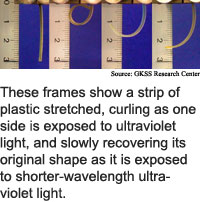
Ultraviolet shifts plastic's
shape
Materials that change shape are potentially
very useful, especially if the shape change is easy to control and takes
place quickly.
Researchers from German organizations GKSS Research Center, Rhine-Westphalia
Institute of Technology (RWTH Aachen) and MnemoScience GmbH, and the Massachusetts
Institute of Technology have concocted a polymer material that can be
switched from one shape to another in the presence of the right wavelengths
of ultraviolet light.
The material could eventually be used in industrial and medical
applications, including intelligent stents and sutures. An intelligent
stent could begin as a string that could be threaded into a blood vessel
through a tiny incision, then activated with ultraviolet light via a fiber-optic
probe to change into a corkscrew-shaped stent that would keep a blood
vessel open. An intelligent suture would form a knot when activated.
The material can be manipulated into a new shape, which is fixed
when the material is illuminated with ultraviolet light with a wavelength
longer than 260 nanometers. The material changes back to the original
shape when illuminated with ultraviolet light below a wavelength shorter
than 260 nanometers. The material can be fixed into many types of shapes,
including elongated films, tubes, arches and spirals. Existing light-activated
shape-memory polymers are limited to expanding, shrinking and bending.
The material is a mix of two polymers. The first forms the material's
original shape, and the second forms cross-links in the presence of ultraviolet
light longer than 260 nanometers. Exposing the material to the shorter
wavelength breaks the cross-links, which allows the material to recover
its original shape.
The polymers hold the second shape even when heated to 50 degrees
Celsius, according to the researchers.
The ultraviolet shape-memory polymers could be used for non-medical
applications in less than five years, and medical applications in five
to ten years, according to the researchers. The work appeared in the April
14, 2005 issue of Nature (Light-Induced Shape-Memory Polymers).
Stories:
Telescopes make bug-eye optics
Summarizer ranks sentences
Impact Assessment:
Overly smart buildings
Briefs:
Ultraviolet shifts plastic's shape
Spiral laser beam demoed
Nanotube chemical sensor gains speed
Trapped cells make micromotors

Research Watch blog
View from the High Ground Q&A
How It Works
RSS Feeds:
News
Ad links:
Buy an ad link
Ad links: Clear History
Buy an ad link
|
TRN
Newswire and Headline Feeds for Web sites
|
© Copyright Technology Research News, LLC 2000-2010. All rights reserved.